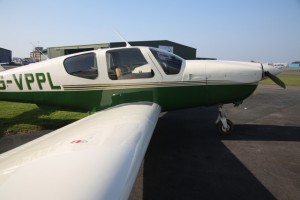Our Aircraft
 We use a Socata TB20 configured especially for the skill test. It was selected because of the following characteristics:
We use a Socata TB20 configured especially for the skill test. It was selected because of the following characteristics:
- It has a fairly large, non-turbocharged engine. This means it can reach FL80, the level typically needed for airways entry quite quickly. Lower powered aircraft may well need to climb in an ad hoc en-route hold in order to enter an airway in level flight.
- It is not turbocharged so can sustain the mild abuse which is implicit in stalls and unusual attitude recoveries.
- It has a large instrument panel allowing for flexibility in layout.
- It has a retractable undercarriage and variable pitch propeller. Although these add a degree of complication it is likely that customers will go on to fly aircraft with these features in the future. Actually lowering the undercarriage to initiate final approach descent is in some ways easier than a power reduction and our standard power settings are designed to minimise RPM changes.
- Having a low wing, two doors, a roomy cabin and a large fuel capacity make the aircraft comfortable and easy to operate in this advanced training role.
- It has gear, flap and crosswind limits that do not restrict us in the intended role.
The aircraft’s expensive and possibly unique avionics set-up has been specifically designed for the skill test. It features duplicated traditional instruments and glass panel which are all in the pilot’s primary field of view. The avionics consist of:
- A mechanical HSI driven by a Garmin 430 for those most comfortable with twirling knobs to select function and round dial to observe performance
- An Aspen PFD driven by a Garmin GTN for those who want a touch screen GPS and a glass cockpit style presentation.
- The Aspen is configured to provide exactly the data we need (such as a continuous wind read-out) but does not display additional maps or needles that are not needed.
- The ADF displays on a two needle RMI. This is the best possible presentation for ADF tracking and the second needle can be driven by the GPS to illustrate or eliminate dip error.
- A Shadin stand-alone fuel flow instrument to avoid the need for an updated fuel log.
- A second altimeter in the P1 panel obviating the need to lean across the cockpit to set it.
- A decent autopilot and flight director that displays on both the traditional HSI and the Aspen PFD
There are unusual facilities for the instructor. These may be less obviously of benefit to the customer but they are valuable. This is because anything that makes the peripheral tasks of the instructor easier, leaves them with more energy to concentrate and do the best instructional job possible. They also provide accurate data that can be used in the debrief..
- A permanently mounted ipad and USB charger (outside the P2 field of view) so they can see local area charts to avoid airspace infringements or to track progress on geo-referenced approach plates or retain a ‘breadcrumb trail’ of your flight path.
- A colour engine monitor providing accurate and obvious engine data
- A stormscope for additional information in the unlikely event of poor weather.
Finally, there are detail touches, proper stowage, decent limit panel screening, specially made longer instrument knobs to ease their operation, the best possible intercom and radio with noise cancelling matching headsets.
Individually none of these things confer huge benefits but taken together they accumulate into a significantly reduced workload and this in turn makes it more likely you will pass the skill test.
